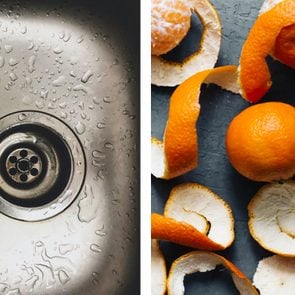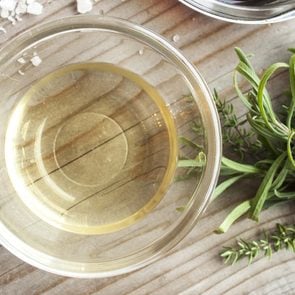We Test 5 Methods to Clean a Burnt Pan—Here’s How They Performed
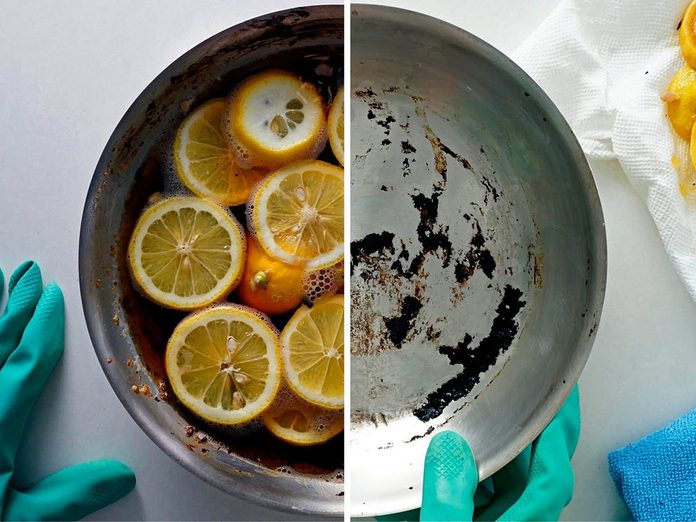
Ever wonder how to clean a burnt pan? See what happened when we put different cleaning methods to the test on our dirtiest skillets.
Whether you burn dinner completely or your pans get dirtier and dirtier over time, eventually you’ll need to have a scouring session at the sink. And for this, the quicker the better! For this reason, we put five methods for cleaning a scorched skillet to the test.
Keep reading to learn how to clean a burnt pan—and see what methods are most effective!
The Testing Method
In an effort to make sure this guide gives you the most accurate results, we put some parameters in place for this skillet scrubbing experiment. All pans tested were made of stainless steel and scorched with the same combination of foods—cheese, eggs and grape jelly.
If the method recommended soaking, we allowed each pan to soak for up to 15 minutes, checking at intervals of 5 minutes and documenting when the charred remains began to lift with ease. We also limited any extra “active scrubbing” to 10 minutes because honestly, who wants to scrub a pan for longer than that?!
All of our “after” photos show what this method achieved within these limits. (Don’t miss this checklist for a sparkling clean kitchen!)
Ratings
Each method is rated on a scale of 1 to 5. Ratings were awarded based on how long each technique took to work its magic, how much extra elbow grease was required to remove the burnt-on food and the overall effectiveness in the cleaning process in terms of how much mess remained on the skillet after cleaning within our set parameters.
Cleaning Techniques for Greasy Skillets
Warning: Before cleaning your pans, test the method on a small, inconspicuous portion to ensure it won’t damage the surface. The methods below are intended for stainless steel cookware and not those with nonstick coatings.
5 Methods for Cleaning a Burnt Pan
Method 1: Baking Soda + Vinegar
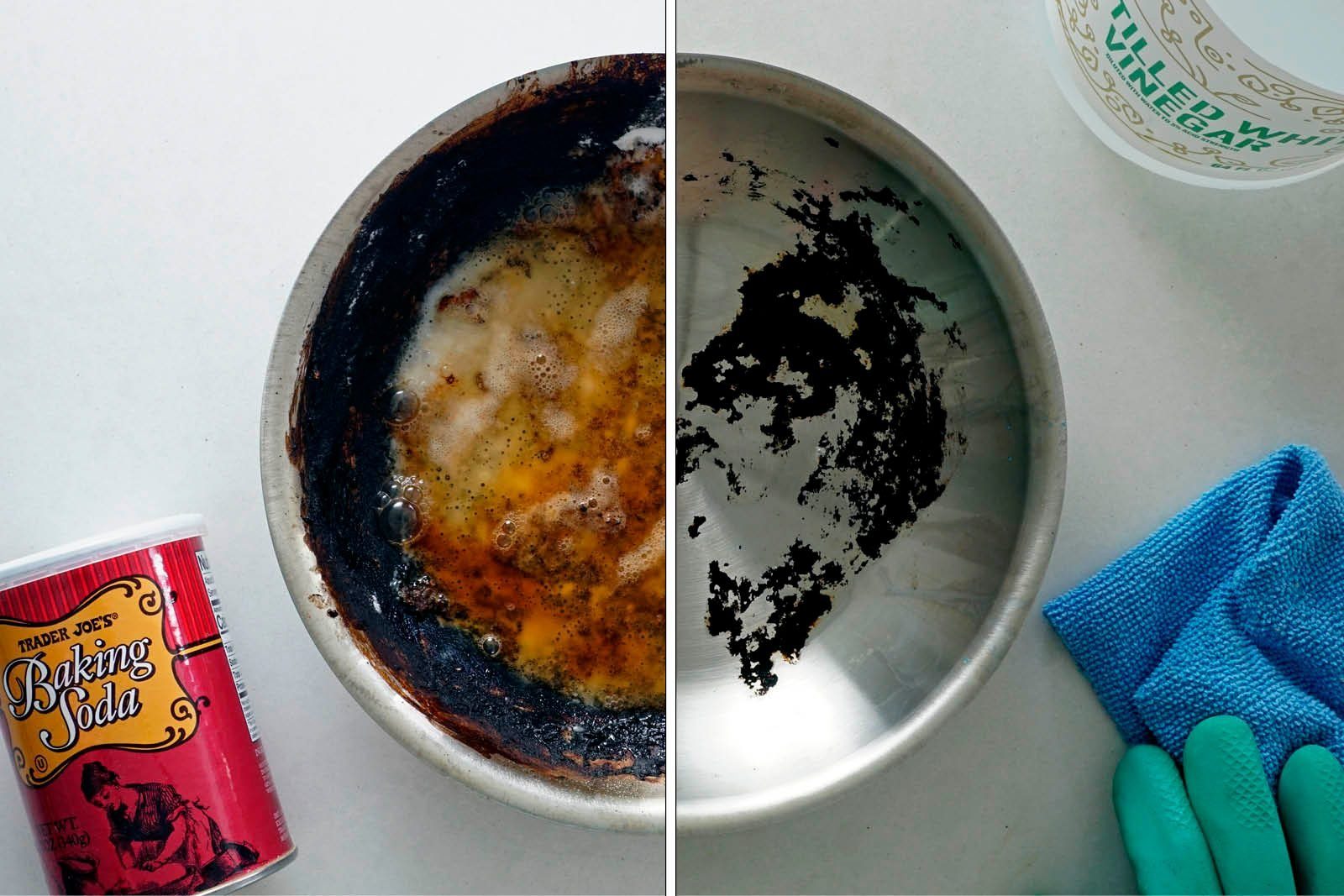
Benefits: This method uses affordable pantry items most people have on hand.
How It Works: Fill your dirty pan with equal part water and vinegar. Bring the mixture to a boil and then add 2 tablespoons of baking soda. Remove from heat and let soak for up to 15 minutes. Discard the liquid down your drain and then use a sponge or scouring pad to scrub away any remaining burnt-on bits. If spots remain, apply a paste made of baking soda mixed with a little water and let sit for a few minutes before scrubbing again.
What Happened: We had high hopes for this method because it fared well when testing the best methods for cleaning baking sheets. After just 5 minutes of soaking, we noticed some charred bits starting to float to the surface! However, we opted to let this one continue to soak for the full 15 minutes since it seemed some stubborn bits were holding fast. After rinsing and 10 minutes of heavy scrubbing with a scouring pad we were able to lift most of the charred, burnt-on food. A follow-up application of baking soda paste was definitely needed and further scrubbing was essential to lift the remaining debris.
Rating: 3/5
Method 2: Lemons
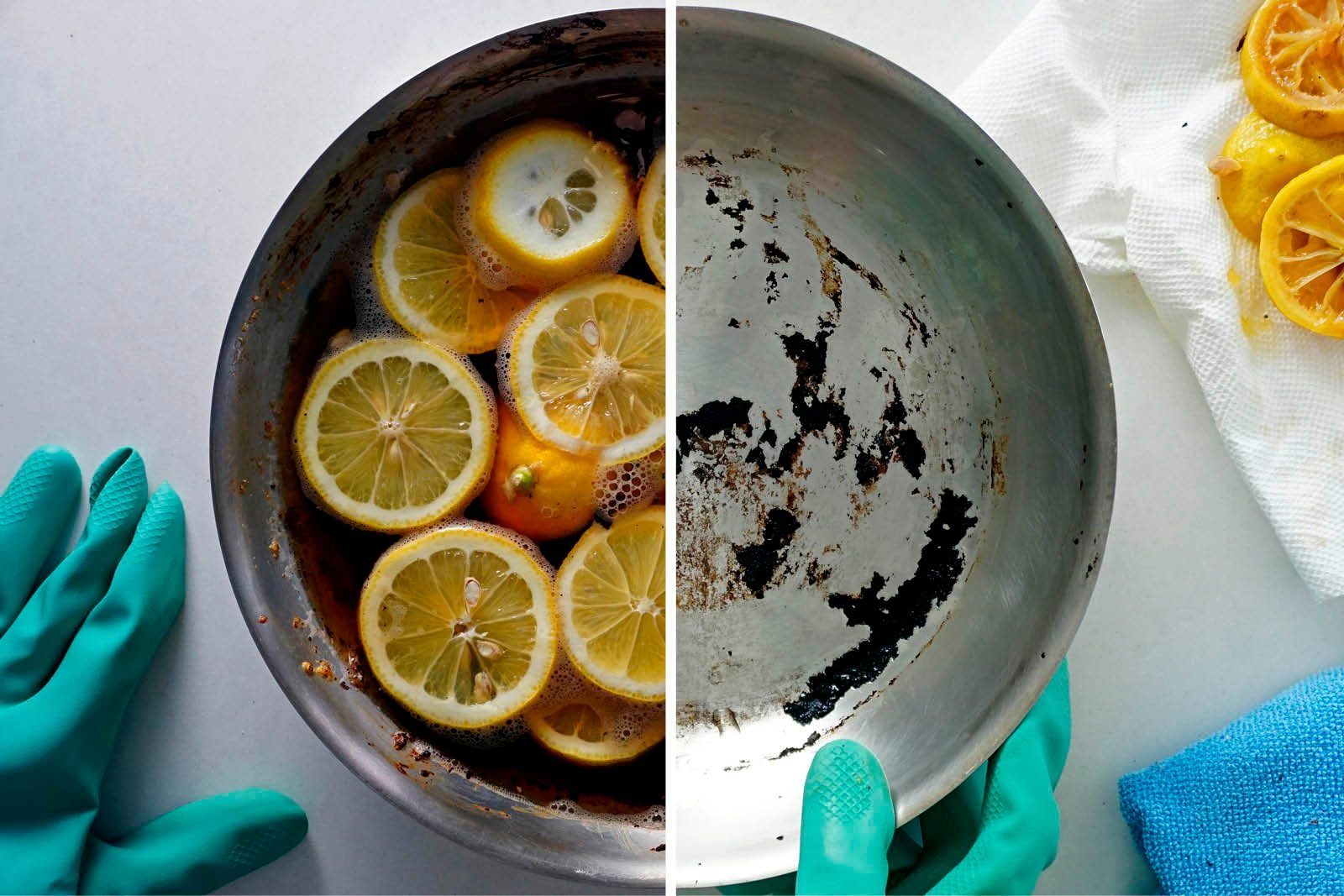
Benefits: This is a great natural cleaning method that doesn’t require any harsh chemicals.
How It Works: Slice 2-3 lemons and arrange them in your dirty pan. Place the pan over medium-high heat and fill with enough water to just barely cover the lemons. Bring the lemon water to a boil for 5-8 minutes and then remove the pan from the heat. You’ll know the pan is ready for a final scrub when you start to see food particles floating to the surface of the water. Discard the lemons and drain the water. Rinse with hot, clean water and use a scouring pad or brush to loosen and remove any stuck-on bits. (Here are 25+ cleaning hacks for hard-to-remove stuff.)
What Happened: This was our least favourite method. While we can appreciate the all-natural approach, it wasn’t as effective for us compared to the other methods we tested. It required quite a bit of heavy-duty scrubbing in hot water to make any real impact on the debris. We think some classic Dawn dish soap would have been just as effective and you wouldn’t have wasted two perfectly good lemons in the process.
Rating: 2/5
Method 3: Bar Keepers Friend
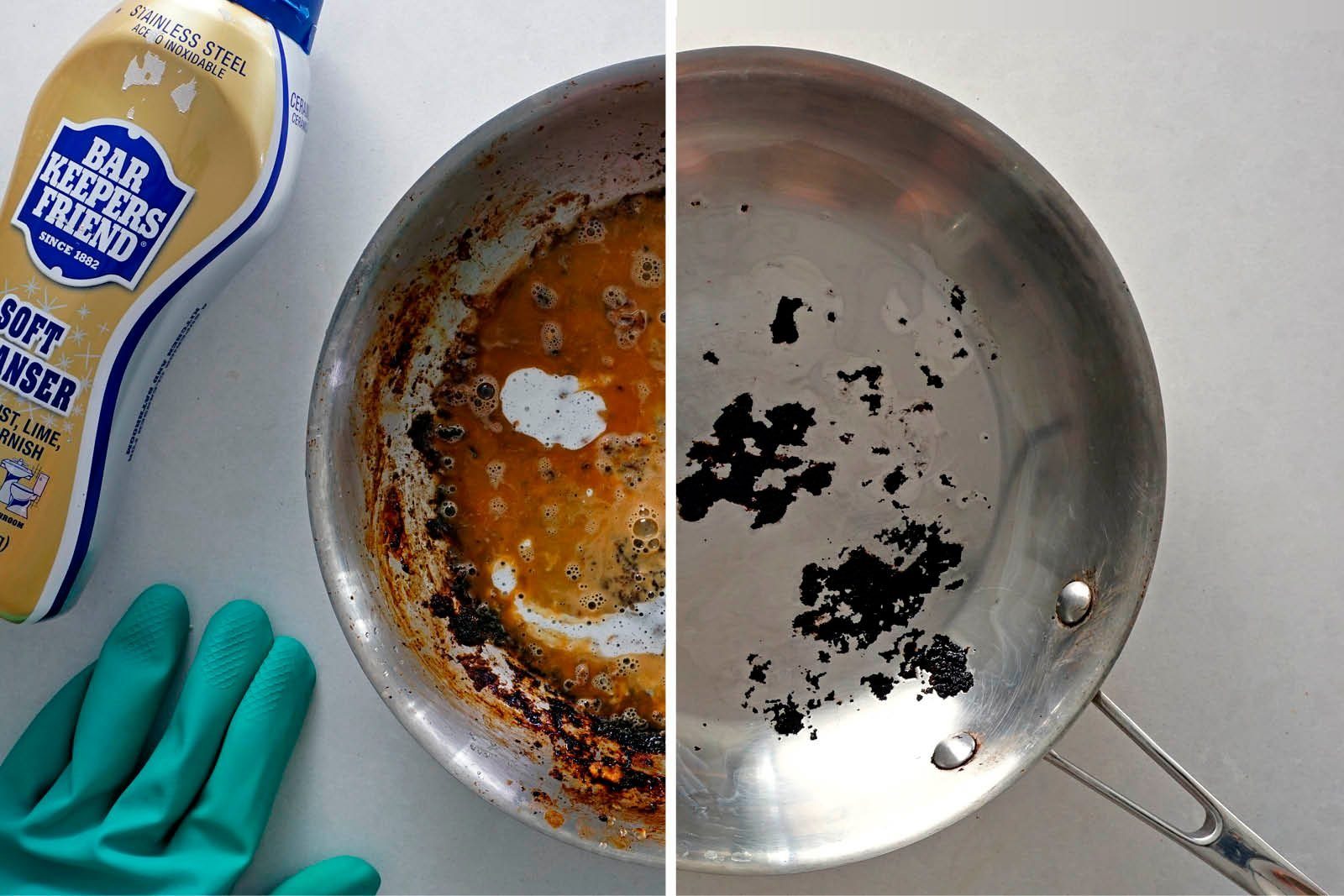
Benefits: This stuff works its magic fast and is a cleaning product you can use on a variety of other surfaces in your home. Made of oxalic acid, Bar Keepers Friend is acidic like vinegar or lemon juice—but much stronger.
How It Works: Run your dirty pan under hot water and drain. Then, wearing rubber gloves, make a paste by rubbing a few tablespoons of Bar Keepers together with the residual water in your dirty pan. Spread the paste over the burnt debris in your pan and let it sit for 60 seconds. Don’t let it sit any longer—this stuff means business. After 60 seconds, rinse your pan thoroughly with hot water and then use a sponge, brush or scouring pad to scrub away the loosened burnt-on food. Repeat this process, if needed, for any stubborn spots.
What Happened: Bar Keepers is one of our favourite cleaning products for the whole home. We had high expectations for this method and it delivered. We were impressed by what we were able to remove after a quick 60-second soak and 10 minutes of scrubbing. The toughest spots were able to be lifted completely with a quick follow-up application and another 2 minutes of scrubbing with a scouring pad.
Rating: 4/5
Method 4: Aluminum Foil + Baking Soda
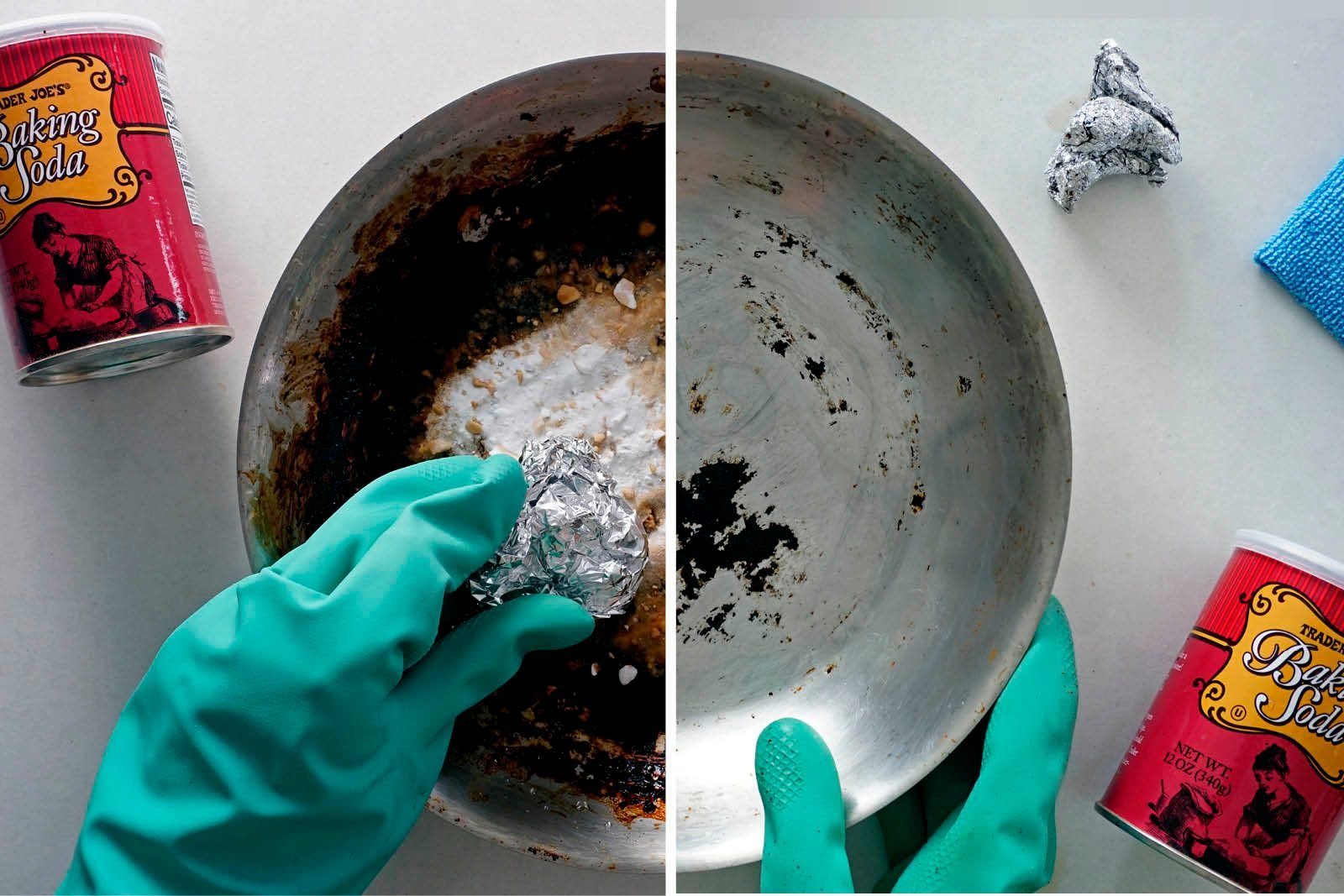
Benefits: Not just for covering leftovers, aluminum foil is also a pretty effective cleaning tool that’s likely in your cupboard already.
How It Works: Rinse your dirty pot in hot water and drain. Then, sprinkle generously with 2 tablespoons of baking soda. Add a few teaspoons of hot water back to your pan to form a paste with the baking soda and then begin scrubbing with a golf ball-sized piece of crumpled foil. Continue scrubbing until all of the burnt debris lifts and then rinse with hot soapy water to finish cleaning.
What Happened: This method yielded pretty great results for us. While a small touch-up with additional baking soda was necessary after an initial scrub, we were impressed by how well the foil really dug away the grime. Ultimately this method is like the “deluxe” version of the baking soda + vinegar method we outlined previously. It works just as well but faster and more effectively thanks to the addition of the foil for enhanced scrubbing power.
Rating: 4/5
Method 5: Dishwasher Tablet
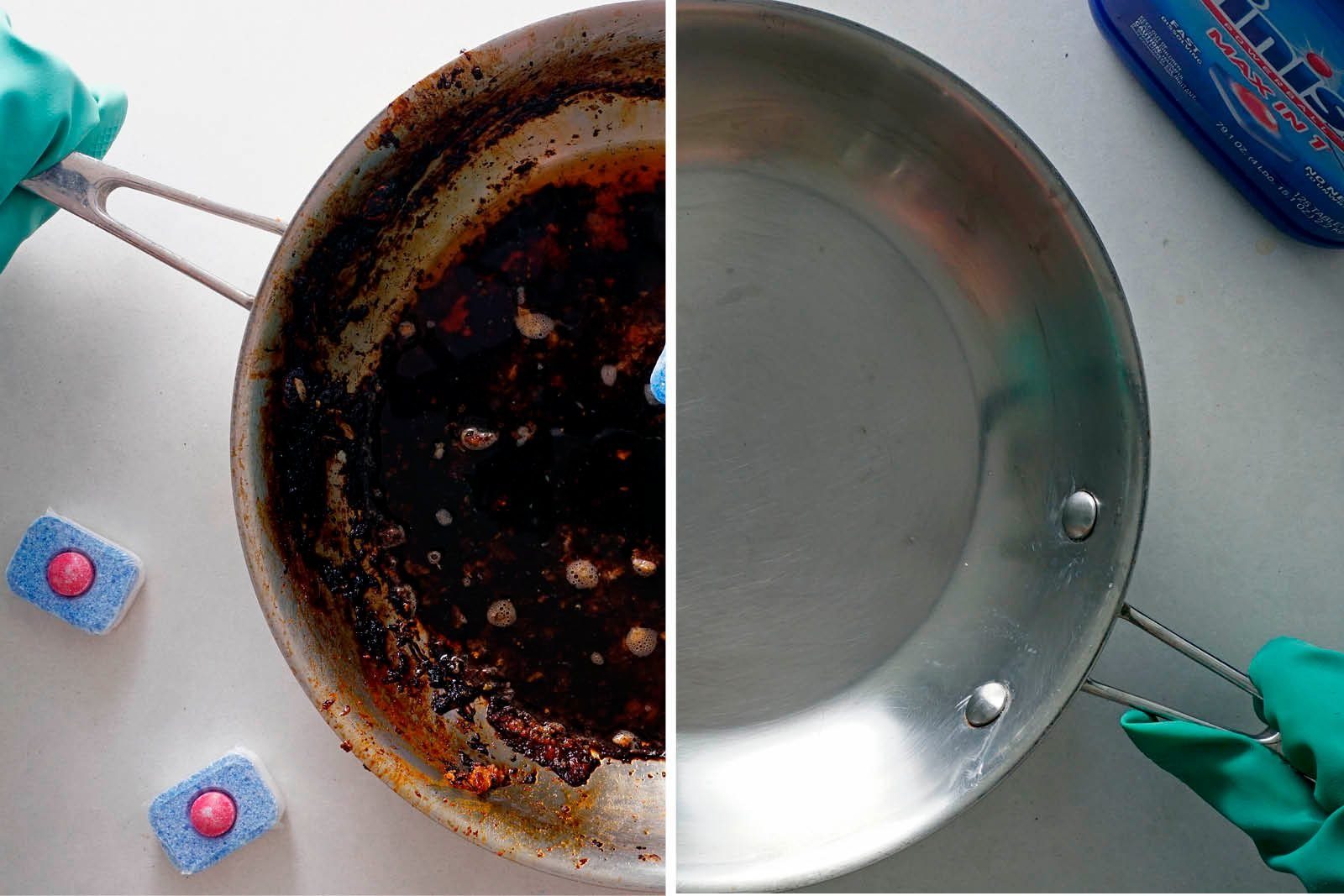
Benefits: If you own a dishwasher, you likely already have a bucket of these on hand.
How It Works: Grab a dishwasher tab from your container and rinse your dirty pan with hot water. Then, begin to gently scrub the pan under warm water with the dishwasher tab. Scrub until all the food debris lifts, and then rinse with warm water.
What Happened: We couldn’t believe how well this method worked! In less than 5 minutes we had a perfectly clean pan that required no follow-up scrubbing with alternative methods. We used Finish Powerball Deep Clean Tabs and found it worked best to leave the plastic coating on the tabs when scrubbing. The warm water will gradually dissolve the tab as you scrub and help the tablet keep its shape rather than crumble immediately between your fingers. The only downside to this method is that we did use two whole dishwasher tablets to clean one nasty pan. Therefore, this method could get pricey. However, it’s so effective, we feel it is well worth the expense. Psst! You can also use dishwasher tablets to clean your oven.
Rating: 5/5
Summary of Results
While all of these methods are effective at scrubbing away the nasties on your skillets, the dishwasher tablets were the undeniable winner in our opinion. While we can’t vouch for other brands of dishwasher tablets, we expect they would be equally effective in lifting grease and burnt-on food.
While the dishwasher tablet was our favourite standalone method, we think the others are all great options—especially Bar Keepers Friend and aluminum foil + baking soda—to use if you’re OK taking a little extra time to get the job done or are willing to use some extra elbow grease.
Next, check out this viral trick to make your pots and pans look brand new.

